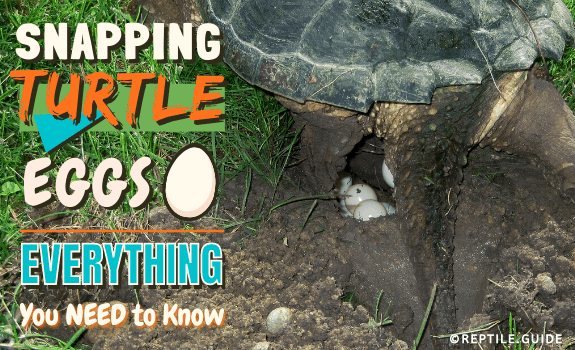If you live near a pond, lake, or stream, you may be lucky. You may be able to live around the common snapping turtle and witness an annual event that’s been playing out the same way for the past 90 million years:
Ironically, as humans encroach on their natural habitat, we create inconvenient or downright dangerous nest sites for snapping turtle eggs that look perfect to their instinctual mothers.
Raised garden beds, road embankments, and compost piles are elevated, receive sun exposure, and easy to dig into.
While momma may think of them as a perfect site, these eggs are now more at risk due to their proximity to humans, cars, and the predators that thrive in our alleyways and fields.
Despite this fact, if you find a snapping turtle nest, you should do nothing.
Snapping turtles have evolved to lay a lot of eggs to increase the odds that at least one will survive. Eggs and hatchlings are also important seasonal food sources for wildlife.
In This Article
In Short
- Snapping turtle eggs look like leathery ping pong balls
- Snapping turtles lay large quantities of eggs, but few survive to maturity
- Common snapping turtle eggs and alligator snapping eggs are quite similar
- Snapping turtle eggs and hatchlings are a food source for many urban predators
- Female snapping turtles lay their eggs as early as February, as late as November, and everywhere in between
Common Snapping Turtle Eggs vs. Alligator Snapping Turtle Eggs
Common Snapping Turtle Eggs:
- Clutch Size: 5-49 eggs
- Nesting Season: April-November
- Incubation Period: 50-125 Days
- Age of Sexual Maturity: 5-13 Years
Alligator Snapping Turtle Eggs:
- Clutch Size: 9-40 eggs
- Nesting Season: February-June
- Incubation Period: 77-112 Days
- Age of Sexual Maturity: 12-21 Years
As you can see, common snapping turtle eggs and alligator snapping turtles are incredibly similar. All of their normal ranges overlap with each other.
Aside from identifying the female that laid the nest, there’s no surefire way to tell them apart – until they hatch.
When Do Snapping Turtles Lay Eggs?
“When do snapping turtles lay eggs?” you may wonder. The answer isn’t quite so simple.
Snapping turtles lay their eggs during the late Spring and throughout Summer. Oviposition (egg-laying) timing is directly related to the turtle’s geographic location.
The alligator snapping turtles of south Florida may lay their eggs as early as February.
Canadian common snapping turtles sometimes lay their eggs as late as November! These late babies often spend their first winter hibernating in the nest.
Mother snapping turtles can retain sperm for up to three years. They don’t need to mate every year to lay eggs.
Where Do Snapping Turtles Lay Their Eggs?
If they’re strictly aquatic, where do snapping turtles lay their eggs? Only amphibians can lay their eggs in the water.
Adult snapping turtles only leave the water for one purpose: to lay their eggs. That’s why so many people witness these modern dinosaurs crossing roads in the warmer months.
Nesting females travel as much as a mile away from the closest bodies of water.
After they leave the water, the hunt is on for an area that has:
- Elevation
- Soft, loose, sandy soil
- Protection from predators
- Suitable temperatures, moisture, and sun exposure
If a mother snapping turtle is disturbed while digging her nest, she’ll abandon it and move to a new, safer location. If this occurs repeatedly, she may become egg-bound and die.
Common nesting sites for snapping turtles include:
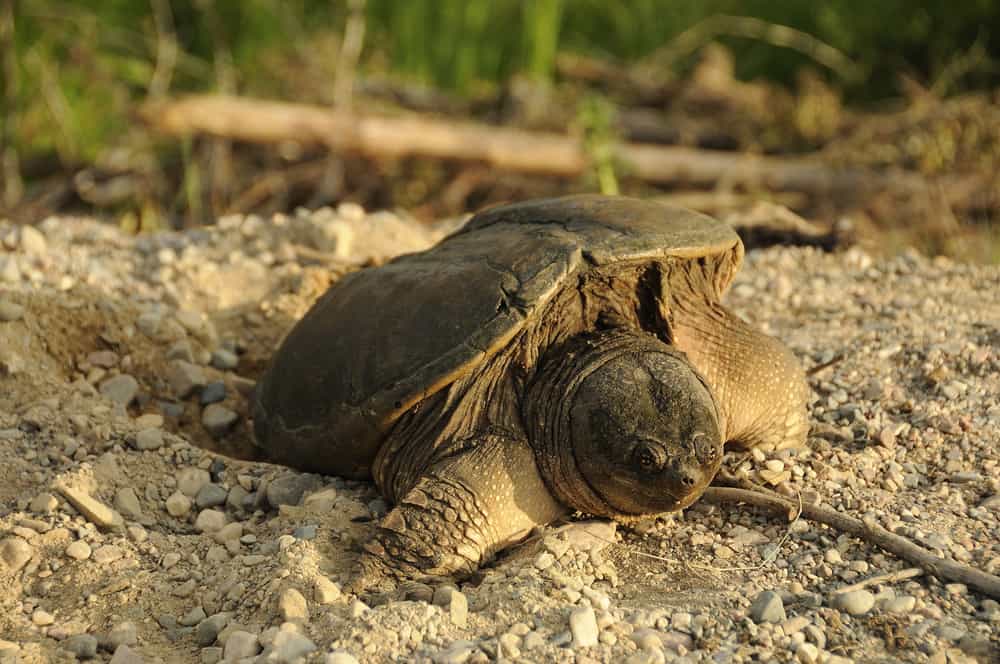
- Lawns
- Garden beds
- Water banks
- Muskrat burrows
- Road embankments
If the ground is too hard to dig, a mother snapping turtle may urinate to moisten the soil. She’ll then dig a bowl-shaped nest, about five to seven inches deep.
After she’s finished laying all of her eggs, she’ll bury them with the same loose soil.
She may urinate again, this time to make the ground easier to pack down. Once it dries, it will harden as a protective layer.
Mother turtles are so skilled at burying their nests that you often don’t even realize where the eggs are unless you observe the laying process.
How Many Eggs Do Snapping Turtles Lay?
If you’ve ever witnessed this time-consuming process, you may have wondered, “How many eggs do snapping turtles lay???”
Snapping turtles can lay as few as 15 to as many as 50 eggs per clutch.
Despite the large quantity, most eggs won’t even hatch, let alone make it to maturity.
Some of the eggs will be infertile, like a chicken egg. Others will develop weaker than their brethren or with lethal deformities.
Biologists estimate that urban predators dig up and consume around 90% of all snapping turtle nests.
Small scavengers like raccoons, coyotes, and crows have learned to thrive near humans.
These predators take advantage of our trash, scraps, and wildlife feeding stations. In turn, their populations are unnaturally high – putting snapping turtle eggs in extra danger.
What Do Snapping Turtle Eggs Look Like?
They’re small, white, and perfectly round. The eggs average out to an inch in diameter.
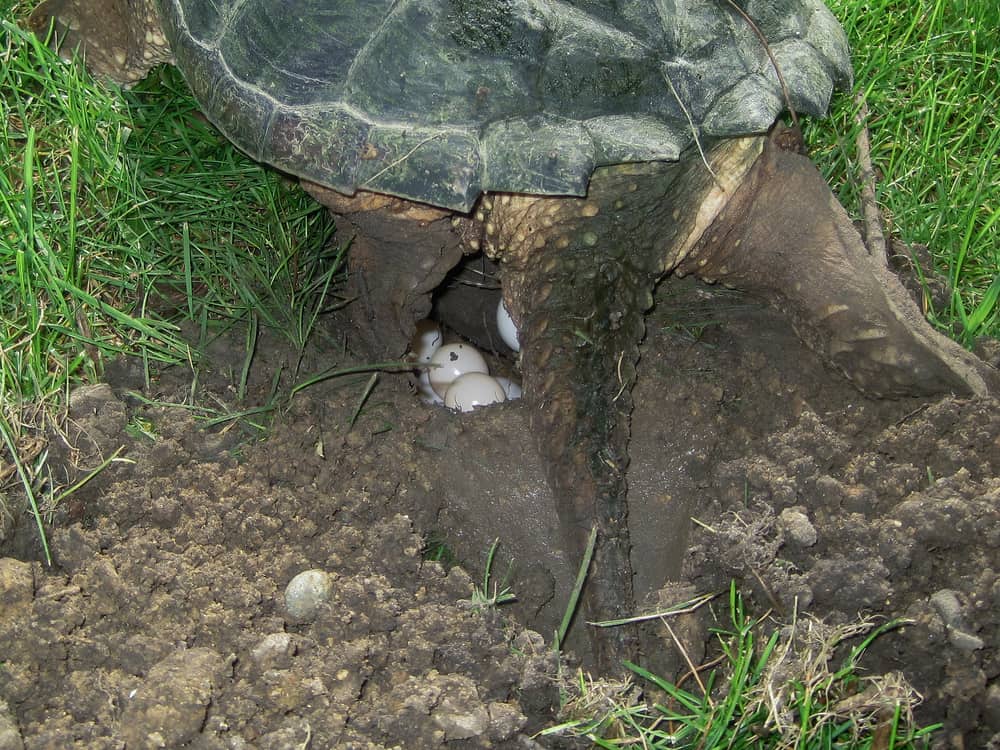
Like snake eggs, their shell is somewhat soft and leathery.
The next time you hear someone ask, “What do snapping turtle eggs look like?” The answer is simple.
Snapping turtle eggs look like ping pong balls.
Snapping Turtle Laying Eggs
Mother snapping turtles may take up to several hours to lay their eggs.
After she digs her nest, she will push one or two eggs out at a time. As she’s pushing, her body lifts. After the eggs fall into the nest, she lowers her body again for a quick rest.
After a mere few moments, her body will lift again, and she’ll pop out another egg or pair of eggs. You can watch a video of a snapping turtle laying eggs here.
When she’s finally finished, she’ll cover the nest up and head back to the water. Rarely, she may stay in the nesting spot to rest for up to 24 hours.
The eggs (and then hatchlings) are left to fend for themselves. This is a fact of life for most species of turtle.
How Long Do Snapping Turtle Eggs Take to Hatch?
“How long do snapping turtle eggs take to hatch?”
The answer to this question is as variable as the habitats that this versatile species occupies.
Snapping turtle eggs can hatch 50 to 180 days after they’re laid. The incubation period largely depends on the local climate (temperature and humidity).
Incubation Period for Snapping Turtle Eggs
The average incubation period for snapping turtle eggs is 80 to 90 days.
Interestingly, the temperature at which the eggs develop will dictate the sex of the hatchlings.
Snapping turtle eggs that incubate under 70°F will be primarily female.
Snapping turtle eggs that incubate at 70-72°F should be an even mixture of males and females.
Snapping turtle eggs that incubate at 73-75°F will be primarily males.
It’s reasonable to assume that year-to-year temperature variations affect the predominant sex that hatches.
Colder years will see more females, while warmer years will see more males.
The temperature-dependent sex development likely has little impact on overall populations.
Most hatchlings don’t make it to adulthood, anyways. Even when they do, they take at least five years to reach maturity.
Snapping Turtle Hatchlings
Snapping turtle hatchlings are tiny! They emerge from their ping pong-sized eggs measuring only an inch long.
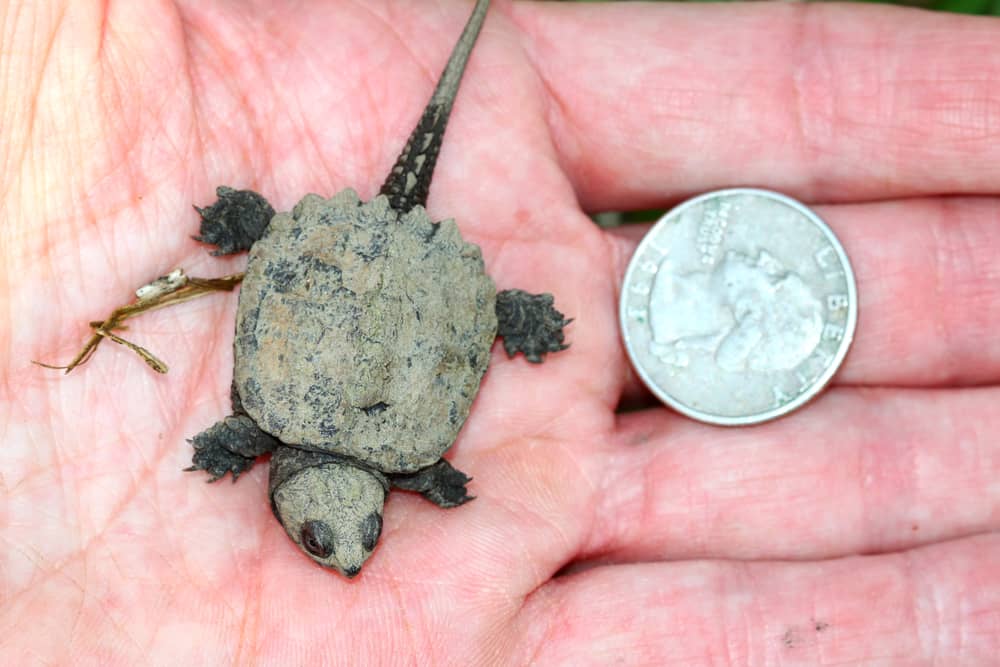
They won’t stay small forever, though!
Their small size and soft shell leave them vulnerable to predators. Moms’ propensity to dig their nests on road embankments put the new babies at risk for vehicular fatalities, too.
Snapping turtles that hatch in the Fall dig out of their nest and head for the closest pond or lake.
If there’s already snow on the ground, they’ll spend the winter hibernating in their nest.
Biologists estimate that each hatchling has less than one-tenth of a percent chance of surviving to adulthood. And the chances are even lower for albino snapping turtles. During their first year, they’re a prime food source for:
- Foxes
- Crows
- Skunks
- Coyotes
- Bullfrogs
- Raccoons
- Opossums
- Birds of prey
- Water snakes
- Large, predatory fish
- Other, larger snapping turtles
Luckily, after they reach adulthood, snapping turtles that live in most regions are safe from predation. Few exceptions exist, like large alligators in the South.
Female turtles are most vulnerable while searching for somewhere to lay eggs. Vehicular collisions and road fatalities are, unfortunately, common.
Moving one adult female snapping turtle off the road (in the direction she was headed) is more impactful than saving dozens of nests.
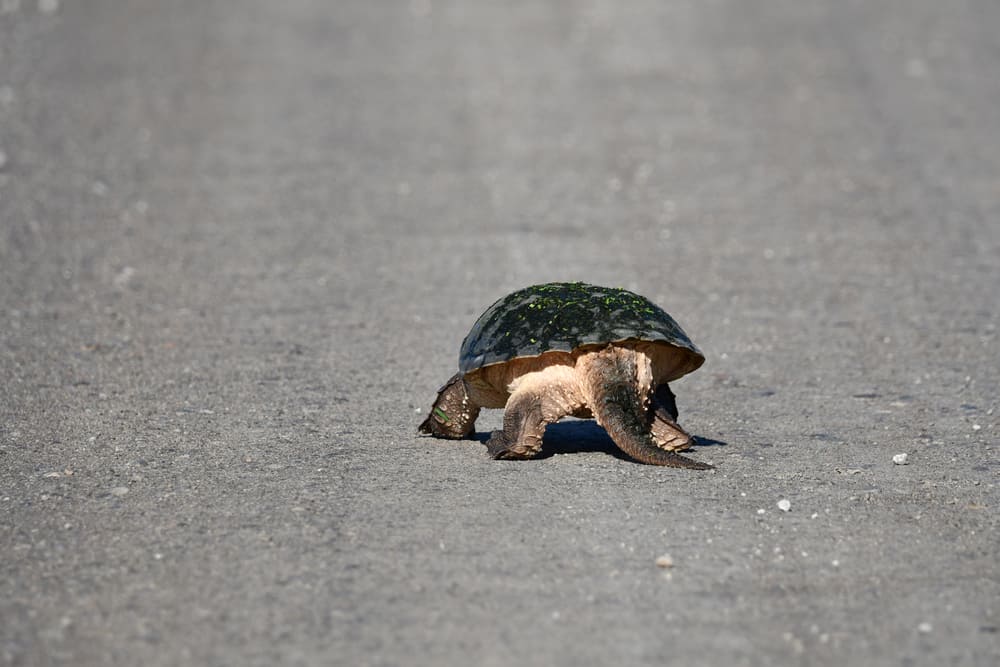
It likely takes female snapping turtles many laying seasons – perhaps even an entire decade – to beat the odds and have a hatchling that survives to adulthood to replace her.
If you’re thinking about incubating a snapping turtle egg to keep it as a pet, please consider a captive-bred turtle that’s better suited for life in captivity.
Baby snapping turtles grow into snappy, hissy giants that are only suitable for experienced reptile keepers.
Have you ever seen one of these impressive modern dinosaurs laying eggs or digging a nest? Leave a comment to tell us about your experiences with snapping turtle eggs.
